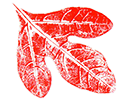New Jersey tea (Ceanothus americanus) is a low-growing, native shrub that can be found throughout most of the eastern half of the U.S. It is an interesting plant from both an ecological standpoint and from a historical / ethnobotanical standpoint.

In the wild, New Jersey tea is typically found in rocky areas, sandy areas, glades, open woods, prairies and abandoned fields. This native shrub can grow 1-5 feet tall, but a mature plant is usually in the range of 2-3 feet tall. It can form suckers at its base and typically takes on a rounded growth form.
New Jersey can also be planted in landscaped settings where it needs full to partial sun and dry to medium moisture soils. It does NOT like heavy, wet soils and may develop root rot if it is kept too wet. In landscaped settings, it makes good specimen shrubs as well as low-growing hedges. The Virginia Native Plant Society named New Jersey tea its Virginia Wildflower of the Year in 2019.
It is often considered a slow growing plant because it puts most of its energy into root growth for the first year or so. The roots include a long, strong, thick taproot, which was said to be able to break a plow. This taproot makes the plant very drought tolerant, but also makes established plants almost impossible to move. In addition, the strong, deep roots make it a good choice for erosion control on rocky slopes or other relatively dry, sunny areas.
A mature New Jersey tea will produce multiple clusters of white flowers in the summer, typically in June to July in Kentucky. The flower clusters can last for about a month and are highly attractive to many different types of bees and butterflies. Even hummingbirds will be attracted to the flowers, both for the nectar and to catch the tiny insects visiting the flowers. New Jersey tea is also a host plant for the caterpillars of the spring azure, summer azure, and mottled duskwing (a type of skipper), as well as a few moth species.
The plant’s value to wildlife continues even after the flowers have quit blooming. Turkey and quail will commonly eat the seeds. Deer and rabbit will also eat the foliage, which can be a problem if you are planting it in an area with high deer or rabbit populations. In that case, you may need to give it some protection until the plant gets established.
The Native Americans used New Jersey tea both medicinally and to create different colored dyes based on whether the flowers, roots, or whole plant were used. After the Boston Tea Party, the leaves of New Jersey tea, along with the leaves of sweet goldenrod, were major components in the caffeine-free herbal tea created by the colonists. In more modern times, chemicals in New Jersey tea have been looked at for hypertension, blood-clotting, and antimicrobials for oral pathogens.
New Jersey tea’s wildlife / pollinator value, history and variety of ethnobotanical uses, and / or simple low-maintenance growth form make it worth considering as a potential native landscape plant for a variety of people with different interests and needs. Many native plant nurseries carry it and you can sometimes find it in traditional nurseries.

This article was part of Shannon’s original Kentucky Pollinators and Backyard Wildlife blog which evolved into the blog for Backyard Ecology.

Backyard Ecology: Exploring Nature in Your Backyard
Nature isn’t just “out there.” It’s all around us, including right outside our doors. Hi, my name is Shannon Trimboli, and I am the host of Backyard Ecology. I live in southcentral Kentucky and am a wildlife biologist, educator, author, beekeeper, and owner of a nursery specializing in plants for pollinators and wildlife conservation. I invite you to join me as we ignite our curiosity and natural wonder, explore our yards and communities, and improve our local pollinator and wildlife habitat. Learn more or subscribe to my email list at www.backyardecology.net.

Leave a Reply